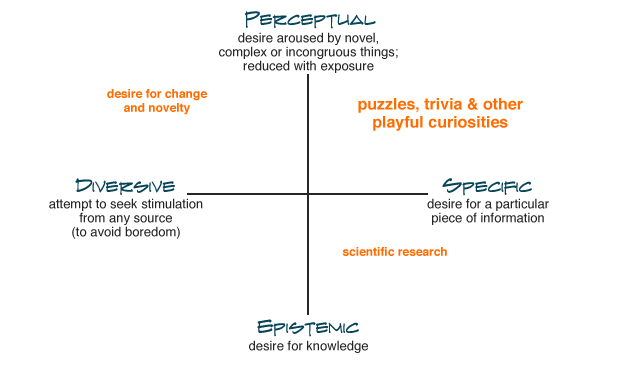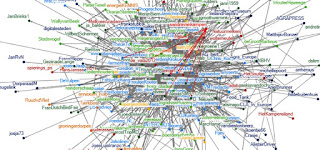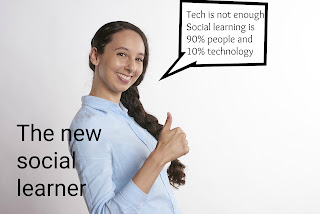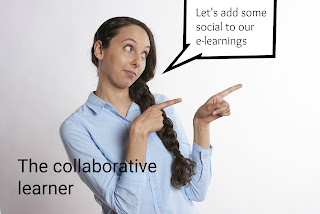For the first time in my life I went to the OEB learning technologies conference in Berlin. It was a great conference. I did not feel tired Friday at 18.00 when it ended, but completely energized and full of new ideas! Thanks to Wilfred Rubens for pointing me to this conference and tips to navigate the conference. I followed his advice of doing a pre-conference session with Jef Staes which was one of my highlights. Wilfred also blogged about the conference. He notices people were looking for practical applications, whereas a conference like this is to challenge your thinking. I had both. My thinking was sharpened, but I also took away really practical lessons for the things I am working on (like the idea to embed peergradio in Moodle for instance....) and new relationships. The day after the conference I spent cycling around Berlin with Natasja, which felt both like a 'dessert' and a cooling down.
Communities of practice are powerful but not appealing
A powerful things happened in the very last session at 17.00 on Friday: my last session was about 'defense and security'. I decided to go there because of my work with the Defense academy in Breda to create an Open Defense Academy. We were 8 in the room, the beamer was ready, as were 4 chairs for a panel, but no convenor or speaker showed up. I had already jokingly appointed someone as the facilitator, who then did take up this role. We decided to exchange. People from Denmark, Finland, the US and the Netherlands exchanged working on 360 degree and VR, e-learning, open academy, video in action, micro learning as support for deployed troops. You could see the recognition, openness to share. It was really an added value to talk about a common sector. I'm sure for some it was the best thing to happen. Still don't know whether the lack of convenor was by purpose or an omission in the program though :).
However the topic of building communities of practice or social learning was not high on the agenda of the conference (neither was performance support). Many sessions were about learning in general (learning a skill or memorizing). The example of driving a car, learning a new profession, onboarding was often used. However there are also many other situations which call for learning, like interdisciplinary learning, learning from mistakes, driving innovation, making use of tacit knowledge, reflection. For innovation and sharing tacit knowledge, (online) communities of practice can be a powerful intervention.
I'm not sure why this focus was much stronger. I guess it is because learning in communities is quite invisible and it takes time. And it does happen even when you don't influence it. L&D professionals may not see they can make a difference? People are aware of the power of networking and connections but may think it is automatic. The art of making space, facilitating, identifying the right domains is hence undervalued. I am one of the facilitators of the LOSmakers, but not doing a good job to create that space for real exchange. Will do that more and try to promote community learning more often (many clients ask for online or blended learning design rather than community design). If you see OEB as a community- who are the convenors, the brokers, where does innovation come from?
AI is real and scary for many
Anita Schjøll Brede did a really good keynote about AI and machine learning. She had five examples of how AI might change the learning landscape, for instance having one (AI) tutor per child, which was long thought too expensive. I learnt French for six weeks with one teacher for myself before going to Mali and that was a great experience. She said one of the challenges is not to copy our own biases into AI. I also attended the chatbot session. Cognitive bots have huge potential, the first wave was Frequently Asked Questions bots, but more is possible. Follow Donald Clark.
I hence visited a boardroom session by Inge de Waard about old philosophers and new learning and had an evening-long discussion about the topic. What I noticed that AI and machine learning does scare people.. Maybe because it is invisible/uncontrollable/difficult to understand? I am not scared because I don't believe in the technological singularity theory. My take away is that L&D-ers have to understand more about machine learning and algorithms, that ethics is becoming more important and that more power is going to the AI programmers who define the algorithms. Plus, L&D-ers need to help people to understand algorithms and burst bubbles. (first idea of L&D as bubble bursters by Ger Driesen). We need people who understand both learning and AI. (Elliot Masie said we can forget about AI for now- that might sound reassuring but I disagree!).
We should move to a 3D-smarts organization /knowmadic way of working
Jef was my hero of the conference. Maybe because his ideas of the 3D-smarts are close to my ideas about knowmads. Let me explain the 3D concept. The difference between the 2D world (before the internet) and 3D world (after the internet) is the ubiquity of information. However, many organizations and schools are still working from the 2D concept, with diplomas and function descriptions. Jef thinks we should move to a competency playlist. In a way I see this is already happening. For instance, as freelance consultant I am never asked for my diplomas, but asked for relevant knowledge or previous assignments. 3D smarting is a merger of working and learning. Jef reaffirmed two ideas:
NB: Again something I missed: I heard few people talking and the important of domain knowledge. I think domain knowledge is becoming more important than soft skills like critical thinking. Learning how to acquire domain knowledge rapidly. Maybe knowledge and skills can not be separated really.
Some very practical stuff
Communities of practice are powerful but not appealing
A powerful things happened in the very last session at 17.00 on Friday: my last session was about 'defense and security'. I decided to go there because of my work with the Defense academy in Breda to create an Open Defense Academy. We were 8 in the room, the beamer was ready, as were 4 chairs for a panel, but no convenor or speaker showed up. I had already jokingly appointed someone as the facilitator, who then did take up this role. We decided to exchange. People from Denmark, Finland, the US and the Netherlands exchanged working on 360 degree and VR, e-learning, open academy, video in action, micro learning as support for deployed troops. You could see the recognition, openness to share. It was really an added value to talk about a common sector. I'm sure for some it was the best thing to happen. Still don't know whether the lack of convenor was by purpose or an omission in the program though :).
However the topic of building communities of practice or social learning was not high on the agenda of the conference (neither was performance support). Many sessions were about learning in general (learning a skill or memorizing). The example of driving a car, learning a new profession, onboarding was often used. However there are also many other situations which call for learning, like interdisciplinary learning, learning from mistakes, driving innovation, making use of tacit knowledge, reflection. For innovation and sharing tacit knowledge, (online) communities of practice can be a powerful intervention.
I'm not sure why this focus was much stronger. I guess it is because learning in communities is quite invisible and it takes time. And it does happen even when you don't influence it. L&D professionals may not see they can make a difference? People are aware of the power of networking and connections but may think it is automatic. The art of making space, facilitating, identifying the right domains is hence undervalued. I am one of the facilitators of the LOSmakers, but not doing a good job to create that space for real exchange. Will do that more and try to promote community learning more often (many clients ask for online or blended learning design rather than community design). If you see OEB as a community- who are the convenors, the brokers, where does innovation come from?
AI is real and scary for many
Anita Schjøll Brede did a really good keynote about AI and machine learning. She had five examples of how AI might change the learning landscape, for instance having one (AI) tutor per child, which was long thought too expensive. I learnt French for six weeks with one teacher for myself before going to Mali and that was a great experience. She said one of the challenges is not to copy our own biases into AI. I also attended the chatbot session. Cognitive bots have huge potential, the first wave was Frequently Asked Questions bots, but more is possible. Follow Donald Clark.
I hence visited a boardroom session by Inge de Waard about old philosophers and new learning and had an evening-long discussion about the topic. What I noticed that AI and machine learning does scare people.. Maybe because it is invisible/uncontrollable/difficult to understand? I am not scared because I don't believe in the technological singularity theory. My take away is that L&D-ers have to understand more about machine learning and algorithms, that ethics is becoming more important and that more power is going to the AI programmers who define the algorithms. Plus, L&D-ers need to help people to understand algorithms and burst bubbles. (first idea of L&D as bubble bursters by Ger Driesen). We need people who understand both learning and AI. (Elliot Masie said we can forget about AI for now- that might sound reassuring but I disagree!).
We should move to a 3D-smarts organization /knowmadic way of working
Jef was my hero of the conference. Maybe because his ideas of the 3D-smarts are close to my ideas about knowmads. Let me explain the 3D concept. The difference between the 2D world (before the internet) and 3D world (after the internet) is the ubiquity of information. However, many organizations and schools are still working from the 2D concept, with diplomas and function descriptions. Jef thinks we should move to a competency playlist. In a way I see this is already happening. For instance, as freelance consultant I am never asked for my diplomas, but asked for relevant knowledge or previous assignments. 3D smarting is a merger of working and learning. Jef reaffirmed two ideas:
- My idea that a knowmad needs to use social media and online. An offline knowmad is simply too slow in a 3D society.
- There is a connection between who you are at home and at work. You cannot be passionate about something and turn that off at home. Sliding and morphing to find your passions and work that fits your talents best. A question for me is that this seems a lifelong struggle?
The challenge for organizations is the power defect. The hunter passes on the spear to his son, but do we do that now? Do we have red monkeys (disruptive ideas) and how do we manage those? In most organizations the disruptive ideas are killed by the settlers. A lesson about change management: disruptive innovation is a change process in which you start with the pioneers and creators. Respect the settlers and followers though. This is a practical lesson for my work with the ambulances.
Some very practical stuff
- Jef Staes had a great idea: 22 posters on stage and everybody who wanted to have a poster will have to make a video to explain the concept on the poster. We do have an online method called "adopt a concept" which is similar but people don't make a video and don't make connections. This is a nice variation.
- The reflection session had a nice BINGO model with numbers. Each number would lead to a different reflection question. (didn't attend this session but will definitely copy this)
- In Jef's session strengthfinder was mentioned as a good tool to help you reflect about your talents and passion. An alternative is the high5 test. I did a great one in 2003 but not sure anymore whether it was the strengthfinder or something with happiness in the name. But number one was love of learning :)
- The facebook MOOCbot was a very creative idea too. A bot would ask design questions and students would design a MOOC. After this a peer review took place, also through the bot. I will try to find out more.
- There is a gamification toolbox with 20 game ideas. You may use it to design your own game and get inspiration through the toolbox, or you can use it to have groups of learners to develop a game and play eachother's game.




 I walked with three colleagues in Milan. We had one day in Milan before the Hofstede Insights conference in which I had to discuss a number of myths about blended learning. If you only have one day in Milan, you obviously want to see the cathedral. I was afraid that we had the wrong exit from the metro, not the exit where "duomo" was written. However, we came out of the metro and Bam! there was the cathedral of Milan. Really super impressive. The cathedral is so big that every exit from the metro leads to it, you can't avoid it ... It's not every day that I get an invitation to do a session about blended learning abroad. Hence, when I received this invitation for Milan I therefore wanted to add a day of tourism. And it worked! I can definitely recommend Milan. The cathedral, but also
I walked with three colleagues in Milan. We had one day in Milan before the Hofstede Insights conference in which I had to discuss a number of myths about blended learning. If you only have one day in Milan, you obviously want to see the cathedral. I was afraid that we had the wrong exit from the metro, not the exit where "duomo" was written. However, we came out of the metro and Bam! there was the cathedral of Milan. Really super impressive. The cathedral is so big that every exit from the metro leads to it, you can't avoid it ... It's not every day that I get an invitation to do a session about blended learning abroad. Hence, when I received this invitation for Milan I therefore wanted to add a day of tourism. And it worked! I can definitely recommend Milan. The cathedral, but also 


 Source: Siobhancribbin.wordpress.com
Source: Siobhancribbin.wordpress.com










